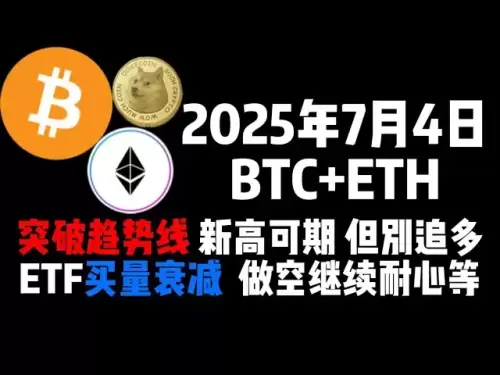-
 Bitcoin
Bitcoin $108,463.3266
-1.47% -
 Ethereum
Ethereum $2,535.8576
-3.62% -
 Tether USDt
Tether USDt $1.0006
0.02% -
 XRP
XRP $2.2352
-2.24% -
 BNB
BNB $658.1049
-0.63% -
 Solana
Solana $149.9207
-2.53% -
 USDC
USDC $0.9998
-0.07% -
 TRON
TRON $0.2857
0.45% -
 Dogecoin
Dogecoin $0.1659
-4.24% -
 Cardano
Cardano $0.5784
-3.85% -
 Hyperliquid
Hyperliquid $38.4944
-4.70% -
 Sui
Sui $2.9107
-4.19% -
 Bitcoin Cash
Bitcoin Cash $485.3637
-3.32% -
 Chainlink
Chainlink $13.3074
-4.18% -
 UNUS SED LEO
UNUS SED LEO $9.0499
0.41% -
 Avalanche
Avalanche $18.0347
-3.98% -
 Stellar
Stellar $0.2394
-2.23% -
 Toncoin
Toncoin $2.8110
-2.68% -
 Shiba Inu
Shiba Inu $0.0...01155
-3.23% -
 Litecoin
Litecoin $87.7967
-3.87% -
 Hedera
Hedera $0.1555
-2.87% -
 Monero
Monero $317.3839
-1.79% -
 Polkadot
Polkadot $3.4144
-4.90% -
 Dai
Dai $1.0000
-0.02% -
 Ethena USDe
Ethena USDe $1.0003
0.00% -
 Bitget Token
Bitget Token $4.4734
-2.29% -
 Uniswap
Uniswap $7.2556
-6.53% -
 Pepe
Pepe $0.0...09693
-7.27% -
 Aave
Aave $267.0924
-4.81% -
 Pi
Pi $0.4834
-3.31%
How to manage ALGO combination orders? How to deal with asynchronous multi-leg transactions?
Managing ALGO combination orders and asynchronous multi-leg transactions is complex but vital for optimizing crypto trading strategies, requiring careful setup and risk management.
May 01, 2025 at 08:07 pm

Managing ALGO combination orders and dealing with asynchronous multi-leg transactions can be complex but crucial for traders looking to optimize their strategies in the cryptocurrency market. In this article, we will delve into the intricacies of these processes, providing detailed guidance on how to effectively manage and execute such orders.
Understanding ALGO Combination Orders
ALGO combination orders refer to the use of algorithmic trading strategies to execute multiple orders simultaneously or in a coordinated manner. These orders are designed to achieve specific trading goals, such as minimizing slippage or maximizing profit from price discrepancies across different markets.
To manage ALGO combination orders effectively, it is essential to understand the types of orders that can be combined. Common types include limit orders, stop orders, and market orders. Each type serves a different purpose and can be used in various combinations to achieve desired outcomes.
For example, a trader might use a limit order to buy a cryptocurrency at a specific price and a stop order to sell it if the price drops to a certain level. By combining these orders, the trader can set up a strategy that automatically manages risk while attempting to capitalize on price movements.
Setting Up ALGO Combination Orders
To set up ALGO combination orders, traders typically use trading platforms that support algorithmic trading. Here's a detailed guide on how to set up such orders:
- Choose a trading platform: Select a platform that supports algorithmic trading, such as Binance, Coinbase Pro, or Kraken. Ensure that the platform offers the necessary tools and APIs for creating and managing ALGO combination orders.
- Define your trading strategy: Clearly outline the goals of your strategy. Are you looking to arbitrage price differences, hedge against volatility, or execute a specific trading pattern? Your strategy will determine the types of orders you need to combine.
- Set up the orders: Use the platform's interface or API to set up the individual orders that make up your ALGO combination. For example, if you're setting up a buy limit order and a sell stop order, you'll need to specify the prices and quantities for each.
- Test the strategy: Before executing the orders with real funds, test your strategy using a demo account or backtesting software. This step helps you identify any potential issues and refine your strategy.
- Monitor and adjust: Once your ALGO combination orders are live, continuously monitor their performance. Be prepared to adjust your strategy based on market conditions and the results of your trades.
Dealing with Asynchronous Multi-Leg Transactions
Asynchronous multi-leg transactions involve executing multiple trades that are not necessarily synchronized. These transactions can be challenging because they require careful timing and management to ensure that all legs of the transaction are completed successfully.
One common scenario where asynchronous multi-leg transactions are used is in arbitrage. Traders might buy a cryptocurrency on one exchange where the price is lower and sell it on another exchange where the price is higher. However, the execution of these trades might not occur simultaneously, leading to potential risks.
To deal with asynchronous multi-leg transactions effectively, traders need to:
- Monitor market conditions: Keep a close eye on the prices and liquidity of the cryptocurrencies involved in your transactions. Use real-time data feeds to stay informed about market movements.
- Use limit orders: To minimize the risk of price slippage, use limit orders instead of market orders. This ensures that your trades are executed at the specified prices, even if it means waiting longer for the orders to be filled.
- Implement risk management strategies: Use stop-loss orders and other risk management tools to protect against adverse price movements. For example, if one leg of your transaction is delayed, a stop-loss order can help limit your potential losses.
- Automate where possible: Use trading bots or algorithms to automate the execution of your multi-leg transactions. Automation can help ensure that your trades are executed according to your strategy, even if you're not actively monitoring the market.
Executing Asynchronous Multi-Leg Transactions
Here's a step-by-step guide on how to execute asynchronous multi-leg transactions:
- Identify the opportunity: Look for price discrepancies or other trading opportunities that can be exploited through multi-leg transactions. Use market analysis tools to identify these opportunities.
- Plan your trades: Decide on the sequence and timing of your trades. For example, if you're executing an arbitrage strategy, you might plan to buy on one exchange and sell on another.
- Set up your orders: Use your trading platform to set up the necessary orders. Ensure that you use limit orders to control the prices at which your trades are executed.
- Execute the trades: Monitor the market and execute your trades according to your plan. Be prepared to adjust your strategy if market conditions change.
- Monitor and adjust: Continuously monitor the status of your trades and be ready to take action if one leg of your transaction is delayed or fails to execute. Use risk management tools to protect your positions.
Managing Risks in ALGO Combination Orders and Asynchronous Multi-Leg Transactions
Managing risks is crucial when dealing with ALGO combination orders and asynchronous multi-leg transactions. Here are some strategies to help you manage these risks effectively:
- Use stop-loss orders: Stop-loss orders can help limit your losses if the market moves against your position. Set these orders at levels that reflect your risk tolerance and trading strategy.
- Diversify your trades: Don't put all your capital into a single strategy or set of trades. Diversify your portfolio to spread risk across different assets and strategies.
- Monitor liquidity: Ensure that the cryptocurrencies you're trading have sufficient liquidity to support your transactions. Low liquidity can lead to slippage and other execution issues.
- Stay informed: Keep up-to-date with market news and events that could impact your trades. Use real-time data feeds and market analysis tools to stay informed.
Troubleshooting Common Issues
When managing ALGO combination orders and dealing with asynchronous multi-leg transactions, traders may encounter several common issues. Here's how to troubleshoot these problems:
- Order execution delays: If your orders are not being executed as expected, check the liquidity of the market and the settings of your orders. Ensure that your limit orders are set at realistic prices and that you're not trading during periods of low liquidity.
- Slippage: Slippage occurs when the price at which your order is executed differs from the price you expected. To minimize slippage, use limit orders and trade in markets with high liquidity.
- Failed transactions: If one leg of your multi-leg transaction fails to execute, assess the reasons for the failure and adjust your strategy accordingly. Use risk management tools to protect your positions and consider automating your trades to reduce the risk of human error.
Frequently Asked Questions
Q: Can I use ALGO combination orders on all cryptocurrency exchanges?
A: Not all cryptocurrency exchanges support ALGO combination orders. It's important to choose a platform that offers the necessary tools and APIs for creating and managing these types of orders. Popular exchanges like Binance and Kraken offer support for algorithmic trading, while others may have limited capabilities.
Q: How do I ensure the security of my ALGO combination orders?
A: To ensure the security of your ALGO combination orders, use strong passwords and enable two-factor authentication on your trading platform. Additionally, consider using a dedicated trading account with limited funds to minimize potential losses from security breaches.
Q: What are the main differences between synchronous and asynchronous multi-leg transactions?
A: Synchronous multi-leg transactions involve executing all legs of the transaction simultaneously, while asynchronous multi-leg transactions allow for the execution of each leg at different times. Synchronous transactions are typically used in scenarios where timing is critical, such as certain arbitrage strategies, while asynchronous transactions offer more flexibility and can be used in a wider range of trading scenarios.
Q: How can I backtest my ALGO combination order strategies?
A: To backtest your ALGO combination order strategies, you can use specialized backtesting software or platforms that offer this feature. Tools like TradingView, QuantConnect, and Backtrader allow you to simulate your trading strategies using historical data, helping you evaluate their performance before executing them with real funds.
Disclaimer:info@kdj.com
The information provided is not trading advice. kdj.com does not assume any responsibility for any investments made based on the information provided in this article. Cryptocurrencies are highly volatile and it is highly recommended that you invest with caution after thorough research!
If you believe that the content used on this website infringes your copyright, please contact us immediately (info@kdj.com) and we will delete it promptly.
- Bitcoin's Pattern Break: Are HODLers the Key to the Next Surge?
- 2025-07-04 18:50:12
- Bitcoin Price, Trump's Bill, and the $150K Dream: A NYC Take
- 2025-07-04 19:50:12
- Ethereum, LILPEPE, and the July Bounce: Will Pepe Steal ETH's Thunder?
- 2025-07-04 19:10:12
- Binance Institutional Loans: Unlocking 4x Leverage and Zero Interest for Whales
- 2025-07-04 19:15:12
- Bitcoin Bull Run: Analysts Eye Peak in Late 2025?
- 2025-07-04 19:20:13
- Pepe Indicators, Bullish Forecast: Can the Meme Coin Rally?
- 2025-07-04 19:25:12
Related knowledge

How to customize USDT TRC20 mining fees? Flexible adjustment tutorial
Jun 13,2025 at 01:42am
Understanding USDT TRC20 Mining FeesMining fees on the TRON (TRC20) network are essential for processing transactions. Unlike Bitcoin or Ethereum, where miners directly validate transactions, TRON uses a delegated proof-of-stake (DPoS) mechanism. However, users still need to pay bandwidth and energy fees, which are collectively referred to as 'mining fe...

USDT TRC20 transaction is stuck? Solution summary
Jun 14,2025 at 11:15pm
Understanding USDT TRC20 TransactionsWhen users mention that a USDT TRC20 transaction is stuck, they typically refer to a situation where the transfer of Tether (USDT) on the TRON blockchain has not been confirmed for an extended period. This issue may arise due to various reasons such as network congestion, insufficient transaction fees, or wallet-rela...

How to cancel USDT TRC20 unconfirmed transactions? Operation guide
Jun 13,2025 at 11:01pm
Understanding USDT TRC20 Unconfirmed TransactionsWhen dealing with USDT TRC20 transactions, it’s crucial to understand what an unconfirmed transaction means. An unconfirmed transaction is one that has been broadcasted to the blockchain network but hasn’t yet been included in a block. This typically occurs due to low transaction fees or network congestio...

How to check USDT TRC20 balance? Introduction to multiple query methods
Jun 21,2025 at 02:42am
Understanding USDT TRC20 and Its ImportanceUSDT (Tether) is one of the most widely used stablecoins in the cryptocurrency market. It exists on multiple blockchain networks, including TRC20, which operates on the Tron (TRX) network. Checking your USDT TRC20 balance accurately is crucial for users who hold or transact with this asset. Whether you're sendi...

What to do if USDT TRC20 transfers are congested? Speed up trading skills
Jun 13,2025 at 09:56am
Understanding USDT TRC20 Transfer CongestionWhen transferring USDT TRC20, users may occasionally experience delays or congestion. This typically occurs due to network overload on the TRON blockchain, which hosts the TRC20 version of Tether. Unlike the ERC20 variant (which runs on Ethereum), TRC20 transactions are generally faster and cheaper, but during...

The relationship between USDT TRC20 and TRON chain: technical background analysis
Jun 12,2025 at 01:28pm
What is USDT TRC20?USDT TRC20 refers to the Tether (USDT) token issued on the TRON blockchain using the TRC-20 standard. Unlike the more commonly known ERC-20 version of USDT (which runs on Ethereum), the TRC-20 variant leverages the TRON network's infrastructure for faster and cheaper transactions. The emergence of this version came as part of Tether’s...

How to customize USDT TRC20 mining fees? Flexible adjustment tutorial
Jun 13,2025 at 01:42am
Understanding USDT TRC20 Mining FeesMining fees on the TRON (TRC20) network are essential for processing transactions. Unlike Bitcoin or Ethereum, where miners directly validate transactions, TRON uses a delegated proof-of-stake (DPoS) mechanism. However, users still need to pay bandwidth and energy fees, which are collectively referred to as 'mining fe...

USDT TRC20 transaction is stuck? Solution summary
Jun 14,2025 at 11:15pm
Understanding USDT TRC20 TransactionsWhen users mention that a USDT TRC20 transaction is stuck, they typically refer to a situation where the transfer of Tether (USDT) on the TRON blockchain has not been confirmed for an extended period. This issue may arise due to various reasons such as network congestion, insufficient transaction fees, or wallet-rela...

How to cancel USDT TRC20 unconfirmed transactions? Operation guide
Jun 13,2025 at 11:01pm
Understanding USDT TRC20 Unconfirmed TransactionsWhen dealing with USDT TRC20 transactions, it’s crucial to understand what an unconfirmed transaction means. An unconfirmed transaction is one that has been broadcasted to the blockchain network but hasn’t yet been included in a block. This typically occurs due to low transaction fees or network congestio...

How to check USDT TRC20 balance? Introduction to multiple query methods
Jun 21,2025 at 02:42am
Understanding USDT TRC20 and Its ImportanceUSDT (Tether) is one of the most widely used stablecoins in the cryptocurrency market. It exists on multiple blockchain networks, including TRC20, which operates on the Tron (TRX) network. Checking your USDT TRC20 balance accurately is crucial for users who hold or transact with this asset. Whether you're sendi...

What to do if USDT TRC20 transfers are congested? Speed up trading skills
Jun 13,2025 at 09:56am
Understanding USDT TRC20 Transfer CongestionWhen transferring USDT TRC20, users may occasionally experience delays or congestion. This typically occurs due to network overload on the TRON blockchain, which hosts the TRC20 version of Tether. Unlike the ERC20 variant (which runs on Ethereum), TRC20 transactions are generally faster and cheaper, but during...

The relationship between USDT TRC20 and TRON chain: technical background analysis
Jun 12,2025 at 01:28pm
What is USDT TRC20?USDT TRC20 refers to the Tether (USDT) token issued on the TRON blockchain using the TRC-20 standard. Unlike the more commonly known ERC-20 version of USDT (which runs on Ethereum), the TRC-20 variant leverages the TRON network's infrastructure for faster and cheaper transactions. The emergence of this version came as part of Tether’s...
See all articles

























































































